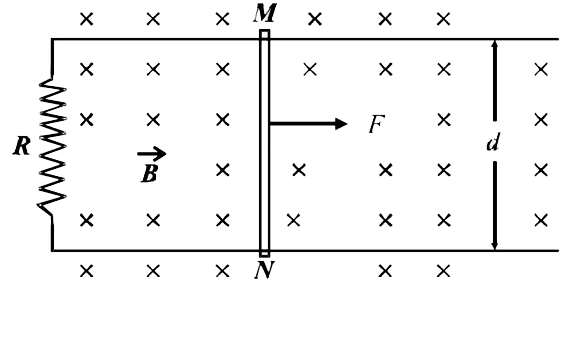Decacarbonyl Dimanganese (0)
I. is made up of two square pyramidal Mn(CO)5 units
II,these units are joined by a Mn-Mn bond
III. Its structure is

The fact(s) is /are
I and II
II and III
I and III
All of these
The correct Answer is:D
Step by step video, text & image solution for Decacarbonyl Dimanganese (0) I. is made up of two square pyramidal Mn(CO)_5 units II,these units are joined by a Mn-Mn bond III. Its structure is The fact(s) is /are by Chemistry experts to help you in doubts & scoring excellent marks in Class 12 exams.
Updated on:21/07/2023Similar Questions
Two long parallel horizontal rails a, a distance d aprt and each having a risistance λ per unit length are joing at one end by a resistance R. A perfectly conduction rod MN of mass m is free to slide along the rails without friction (see figure). There is a uniform magnetic field of induction B normal to the plane of the paper and directed into the paper. A variable force F is applied to the rod MN such that, as the rod moves a constant current flows through R.

(i) Find the velocity of the rod and the applied force F as function of the distance x of the rod from R.
(ii) What fraction of the work done per second by F is converted into heat?
View SolutionA point moves in the XY-plane such that the sum of it’s distances from two mutually perpendicular lines is always equal to 5 units. The area enclosed by the locus of the point is in square units is x then sum of the digits of x is
View Solution
Knowledge Check
[Mn2(CO)10] is made up of _________ units joined by a Mn-Mn bond.
Atwo square pyramidal Mn(CO)5Bthree square pyramidal Mn(CO)5Ctwo pentagonal Mn(CO)5Dtwo trigonal bipyramidal Mn(CO)5Two Mn(CO)5 units are joined by ________ bond to form decarbonyl dimanganese (0).
AMn-COBCO-COChydrogenDMn-MnAmong the following statements:-
I. PCl5 is trigonal bipyramidal wheras IF5 is square pyramidal.
II. Bond enthalpy of O−H bond in water and ethanol is different.
III. All carbon atoms have same hybridisation in carbon suboxide (C3O2)
Find out the correct statements.AI & II onlyBII & III onlyCI & III onlyDI, II & III
For M2+/M and M3+/M2+ system, E∘ values for some metals are as follows ,
Cr2/Cr=−0.9Vl,Cr3+/Cr2=−0.4V,Mn2+/Mn=−1.2V,Mn3+/Mn2+=+1.5V,Fe2+/e=−0.4V,Fe3+/Fe2+=+0.8V
Use this data to comment upon
(i) the stability of Fe3+ in acid solution as compared to that of Cr3+ and Mn3+
(ii) the case with which iron can be oxidized as compared to the similar process for either Cr or Mn metals.
View SolutionHow would you account for the following ?
(i) The atomic radii of the metals of the third (5d) series of transition elements are virtually the same as those of the corresponding members of the second (4d) series.
(ii) The E∘ value for the Mn3+/Mn2+ couple is much more positive than that for Cr3+/Cr2+ couple or Fe3+/Fe2+ couple.
(iii) The highest oxidation state of a metal is exhibited in its oxide or fluoride.
View SolutionTwo important physical evidences supporting the synergic bonding in non-classical complexes are bond lengths and vibrational spectra. Vibrational spectra is based on the fact that the compression and extension of a bond may be analogous to the behaviour of a spring and obeys Hook's law.
¯v=12πc√kμcm−1
where, k=force force constant of the bond which is directly proportional to bonnd strength of CO μ=reduced mass of ligand
¯v=stretching frequency of the CO bond
c=velocity of light
Q. In Mn2(CO)10 carbonyl complex, the d-orbital of Mn-atom which can not be involved in synergic bonding betwee Mn and CO ligands:
View SolutionTwo important physical evidences supporting the synergic bonding in non-classical complexes are bond lengths and vibrational spectra. Vibrational spectra is based on the fact that the compression and extension of a bond may be analogous to the behaviour of a spring and obeys Hook's law.
¯v=12πc√kμcm−1
where, k=force force constant of the bond which is directly proportional to bonnd strength of CO μ=reduced mass of ligand
¯v=stretching frequency of the CO bond
c=velocity of light
Q. In Mn2(CO)10 carbonyl complex, the d-orbital of Mn-atom which can not be involved in synergic bonding betwee Mn and CO ligands:
View SolutionThe dot product of two vectors of magnitudes 3 units and 5 units cannot be :-
(i) -20 (ii) 16 (iii) -10 (br) 14
View Solution
